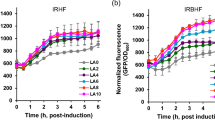Abstract
The bacterial strain DSM 9103, able to utilize EDTA as a sole source of carbon, nitrogen, and energy, is also capable to grow with [S,S]-ethylenediaminedisuccinate ([S,S]-EDDS), a structural isomer of EDTA. In cell-free extracts of[S,S]-EDDS-grown bacteria, [S,S]-EDDS degradation was observed in the absence of any cofactors. An enzyme was purified41-fold that catalyzed the non-hydrolytic splitting of[S,S]-EDDS leading to the formation of fumarate and N-(2-aminoethyl) aspartic acid. These data strongly suggest that the enzyme belongs to the group of carbon-nitrogen lyases. The splitting reaction was reversible, and an equilibrium constant of approximately 43.0 10-1 M was determined. Out of the three stereo-isomers of EDDS, [S,S]-and [R,S]-EDDS were accepted as substrates by the lyase,whereas [R,R]-EDDS remained unchanged in assays with both cell-free extracts and pure enzyme. The enzyme catalyzed the transformation of free [S,S]-EDDS and of [S,S]-EDDS-metal complexes with stability constant lower than 10, namely of MgEDDS, CaEDDS, BaEDDS and to a small extent also of MnEDDS;FeIIIEDDS, NiEDDS, CuEDDS, CoEDDS and ZnEDDS were not transformed.
Similar content being viewed by others
References
Alder AC, Siegrist H, Gujer W & Giger W (1990) Behaviour of NTA and EDTA in biological wastewater treatment. Wat. Res. 24: 733–742
Auling G, Busse H-J, Egli T, El-Banna T & Stackebrandt E (1993) Description of the Gram-negative, obligately aerobic, nitrilotriacetate (NTA)-utilizing bacteria as Chelatobacter heintzii, gen. nov., sp. nov., and Chelatococcus asaccharovorans, gen. nov., sp. nov. Syst. Appl. Microbiol. 16: 104–112
Bradford MM (1976) A rapid and sensitive method for the quantifi-cation of microgram quantities of proteins utilizing the principle of protein-dye binding. Anal. Biochem. 72: 248–254
Cebulla I (1995) Gewinnung komplexbildender Substanzen mittels Amycolatopsis orientalis. PhD thesis, Eberhard-Karls-Universität Tübingen, Germany
Dietz F (1987) Neue Meßergebnisse über die Belastung von Trinkwasser mit EDTA. gwf Wasser Abwasser 128: 286–288
Egli T (1988) (An)aerobic breakdown of chelating agents used in household detergents. Microbiol. Sci. 5: 36–41
Egli T, Weilenmann HU, El-Banna T & Auling G (1988) Gram-negative, aerobic, nitrilotriacetate-utilizing bacteria from wastewater and soil. Syst. Appl. Microbiol. 10: 297–305
Frimmel FH, Grenz R, Kordik E & Dietz F (1989) Nitrilotriacetat (NTA) und Ethylendinitrilotetraacetat (EDTA) in Fließgewässern der Bundesrepublik Deutschland. Vom Wasser 72: 175–184
Gorelov IP, Samsonov AP, Nikol'skii VM, Babich VA, Svetogorov YE, Smirnova TI, Malakhaev ED, Kozlov YM & Kapustnikov AI (1978) Synthesis and complex-forming properties of complexons derived from dicarboxylic acids. V. Synthesis of complexons derived from succinic acid. Russ. J. Gen. Chem. 49: 659–663
Hartman FA & Perkins CM (1987) Detergent compositions containing ethylenediamine-N,N'-disuccinic acid. U.S. patent 4,704,233
Houriet J-P (1996) NTA dans les eaux. Cahier de l'environnement 264. Office fédéral de l'environnement, des forêts et du paysage (OFEFP), Berne, Switzerland
Kari FG (1994) Umweltverhalten von Ethylendiamintetraacetat (EDTA) unter spezieller Berücksichtigung des photochemischen Abbaus. PhD thesis No. 10698, Swiss Federal Institute of Technology, Zürich, Switzerland
Kovaleva IB, Mitrofanova ND & Martynenko LI (1992) The structure of transition metal complexonates derived from ethylenediamine-(N,N')-disuccinic acid. Russ. J. Inorg. Chem. 37: 41–45
Lämmli UK (1970) Cleavage of structural proteins during the assambly of the head of bacteriophage T4. Nature 227: 680–685
Ludwig P, Gunkel W & Hühnerfuss H (1992) Chromatographic separation of the enantiomers of marine pollutants. Part 5: Enantioselective degradation of phenoxycarboxylic acid herbicides by marine microorganisms. Chemosphere 24: 1423–1429
Martell AE & Smith RM (1974) Critical stability constants, Vol 1: Amino acids. Plenum Press, New York
Neal JA & Rose NJ (1968) Stereospecific ligands and their complexes. I. A cobalt(III)complex of ethylenediaminedisuccinic acid. Inorg. Chem. 7: 2405–2412
Nickel K, Suter MJ-F & Kohler H-P (1997) Involvement of two α-ketoglutarate-dependent dioxygenases in the enantioselective degradation of (R)-and (S)-mecoprop by Sphinogomonas herbicidovorans MH. J. Bacteriol. 179: 6674–6679
Nishikiori T, Okuyama A, Naganawa T, Takita T, Hamada M, Takeuchi T, Aoyagi T & Umezawa H (1984) Production by actinomycetes of (S,S)-N,N'-ethylenediaminedisuccinic acid, an inhibitor of phospholipase C. J. Antibiot. 37: 426–427
Nowack B (1996) Behaviour of EDTA in groundwater-a study of the surface reactions of metal-EDTA complexes. PhD thesis No. 11392, Swiss Federal Institute of Technology, Zürich, Switzerland
Pavelcik F, Garaj J & Majer J (1980) Lithium [(R,S)-N,N'-ethylenediaminedisuccinato]cobaltate(III) trihydrate. Acta Chryst. B36: 2152–2154
Schneider RP, Zürcher F, Egli T & Hamer G (1988) Determination of nitrilotriacetate in biological matrices using ion exclusion chromatography. Anal. Biochem. 173: 278–284
Schowanek D, Feijtel TCJ, Perkins CM, Hartman FA, Federle TW & Larson RJ (1997) Biodegradation of [S,S], [R,R] and mixed stereoisomers of ethylene diamine disuccinic acid (EDDS), a transition metal chelator. Chemosphere 34: 2375–2391
Simoni S, Klinke S, Zipper C, Angst W & Kohler H-P (1996) Enantioselective metabolism of chiral 3-phenylbutyric acid, an intermediate of linear alkylbenzene degradation, by Rhodococcus rhodochrousPB1. Appl. Environ. Microbiol. 62: 749–755
Tett VA, Willetts AJ & Lappin-Scott HM (1994) Enantioselective degradation of the herbicide mecoprop [2-(2-methyl-4-chlorophenoxy)propionic acid] by a mixed and pure bacterial culture. FEMS Microbiol. Ecol. 14: 191–200
Witschel M, Nagel S & Egli T (1997) Identification and characterization of the two-enzyme system catalyzing the oxidation of EDTA in the EDTA-degrading bacterial strain DSM 9103. J. Bacteriol. 179: 6937–6943
Wolf K & Gilbert PA (1992) EDTA-Ethylenediaminetetraacetic acid. In: Hutzinger O (Ed) The Handbook of Environmental Chemistry, Vol 3 (pp 243–259). Springer, Berlin Heidelberg
Xun L, Reeder RB, Plymale AE, Girvin DC & Bolton H (1996) Degradation of metal nitrilotriacetate complexes by nitrilotriacetate monooxygenase. Environ. Sci. Technol. 30: 1752–1755
Zipper C, Nickel K, Angst W & Kohler H-PE (1996) Complete microbial degradation of both enantiomers of the chiral herbicide mecopropo [(RS)-2-(4-chloro-2-methylphenoxy)propionic acid] in an enantioselective manner by Sphinogmonas herbicidivoranssp. nov. Appl. Environ. Microbiol. 62: 4318–4322
Author information
Authors and Affiliations
Rights and permissions
About this article
Cite this article
Witschel, M., Egli, T. Purification and characterization of a lyase from the EDTA-degrading bacterial strain DSM 9103 that catalyzes the splitting of [S,S]-ethylenediaminedisuccinate, a structural isomer of EDTA. Biodegradation 8, 419–428 (1997). https://doi.org/10.1023/A:1008267931018
Issue Date:
DOI: https://doi.org/10.1023/A:1008267931018




